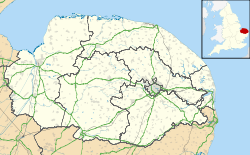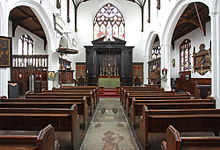- Church of St John Maddermarket
-
Church of Saint John Maddermarket 
Church of St John Maddermarket from the southeastLocation in Norfolk Coordinates: 52°37′48″N 1°17′34″E / 52.6300°N 1.2927°E OS grid reference TG 229 087 Location Maddermarket, Norwich, Norfolk Country England Denomination Anglican Website Churches Conservation Trust History Dedication Saint John the Baptist Architecture Functional status Redundant Heritage designation Grade I Designated 26 February 1954 Architectural type Church Style Gothic Specifications Materials Flint with stone and brick dressings; some ashlar The Church of St John Maddermarket, is a redundant Anglican church in the city of Norwich, Norfolk, England. It has been designated by English Heritage as a Grade I listed building,[1] and is under the care of the Churches Conservation Trust.[2]
Contents
History
There may have been a church on the site in the 11th century, but the earliest fabric in the present church dates from the 14th century. Most of the church dates from a major rebuilding between about 1445 to 1510. At some time the east end of the church was shortened.[3] There has been a tradition that this took place in 1578 when the street was widened for a visit by Elizabeth I,[2][3] but this is considered to be untrue.[4] Following this, the major changes were to the interior of the church. At some time a medieval chancel screen was removed. In 1849 a gallery was installed at the west end. Restorations took place in the 19th century; these included rebuilding the tower in 1822, and refurbishing the interior of the roof and rebuilding the walls in 1863.[3] Also in 1863 the interior was reordered.[4] There was a gas explosion in 1876, in which much of the stained glass was damaged.[3] At the beginning of the 20th century the vicar, Rev William Busby, installed items of furniture collected from other churches.[2] In 1914–15 work was done on the Lady Chapel. The church was closed for Anglican worship in 1982, and used by a community from the Greek Orthodox Church until 1990, when it was vested in the Churches Conservation Trust.[3]
Architecture
Exterior
The church is constructed mainly in flint with stone and brick dressings. The clerestory is faced with ashlar. The aisles are roofed with lead, and the rest of the church is slated. Its plan consists of a four-bay nave and chancel in one unit, north and south aisles extending the full length of the church, north and south porches, a north vestry, and a west tower.[1] The east ends of the aisles have been converted into chapels, the south chapel being the Lady Chapel and on the north side the Jesus Chapel.[3] The church is almost as wide as it is long.[2] The tower is in four stages with diagonal buttresses. The bottom stage is open to the north and south, providing a passage for processions; the west arch is blocked.[1] Above this is a rib vault decorated with twelve carved bosses.[4] Over the west arch is a three-light Perpendicular window. In the top stage are three-light louvred bell openings on each side. The parapet is crenellated, with corner pinnacles and statues. Along the south wall of the south aisle are five buttresses, with three three-light windows in the eastern bays. The western bay incorporates a two-storey porch. Under the easternmost window is a priest's door.[1] Also on the south wall is a sundial dating from the 17th or 18th century.[3] Along the clerestory are eight three-light Perpendicular windows. At the east end of the chancel is a large five-light window with Decorated tracery, and at the east end of each aisle is a three-light window. The north porch also has two storeys. The arch over its doorway is decorated with a band of shields, and over the arch is a niche for a statue and a three-light square-headed window.[1]
Interior
At the east end of the church the altar is surrounded by a massive wooden surround, known as a baldachin. It is thought that this had been made for the church of St Miles Coslany in 1741 and moved into St John's in 1917.[4] Behind the altar is a painting of the Last Supper attributed to the Renaissance painter Livio Agresti. There is another altar in the north aisle. The font dates from 1864, and is decorated with inlaid pieces of coloured marble. The pulpit dates from the same year. Above it is a sounding board from the 17th century.[3] The revolving lectern dates from the 18th century, and is probably Italian. Around the wall of the church are memorials to some of the major historical personages[4] including Joseph Stannard a Norwich School artist of predominately marine-scenes, Walter Nugent Monck founder of the Maddermarket Theatre and to Margaret Howard, Duchess of Norfolk, who died in 1563.[5] The church also houses the Layer monument and commemorations of several other mayors of the City throughout the centuries including the Southerton's, Segram and Bubbin can be found. There are also brasses, the oldest dating from the middle of the 15th century.[3] Most of the stained glass dates from the 19th and 20th centuries, although there are fragments of 15th-century glass in the centre window of the north aisle. The east window dates from 1870 and depicts the healing of the Centurion's daughter. In the north chapel is a depiction of the Annunciation made by Powell's, and in the south chapel is a Tree of Jesse from 1916, probably by King of Norwich.[4] The two-manual organ was made in 1888 by Norman and Beard for St Peter's Church, Lowestoft.[6] It was moved to Norwich in 1904. In 1913 it was rebuilt by Norman and Beard, and moved to the west gallery.[7]
See also
- List of churches preserved by the Churches Conservation Trust in the East of England
References
- ^ a b c d e "Church of St John the Baptist, Norwich", Heritage Gateway website (Heritage Gateway (English Heritage, Institute of Historic Building Conservation and ALGAO:England)), 2006, http://www.heritagegateway.org.uk/Gateway/Results_Single.aspx?uid=229568&resourceID=5, retrieved 24 February 2011
- ^ a b c d Church of St John Maddermarket, Norwich, Norfolk, Churches Conservation Trust, http://www.visitchurches.org.uk/Ourchurches/Completelistofchurches/Church-of-St-John-Maddermarket-Norwich-Norfolk/, retrieved 25 March 2011
- ^ a b c d e f g h i Hollinshead, Liz (2003), The Church of St John the Baptist Maddermarket, Norwich: Information for Teachers, London: Churches Conservation Trust
- ^ a b c d e f St. John Maddermarket, Norwich Historic Churches Trust, http://www.norwich-churches.org/St%20John%20Maddermarket/home.shtm, retrieved 24 February 2011
- ^ Lady Margaret Howard 1540-1563/4, Norwich Historic Churches Trust, http://www.norwich-churches.org/monuments/Elizabeth%20Howard/Elizabeth%20Howard.shtm, retrieved 24 February 2011
- ^ Suffolk, Lowestoft, St. Peter (D05289), British Institute of Organ Studies, http://www.npor.org.uk/cgi-bin/Rsearch.cgi?Fn=Rsearch&rec_index=D05289, retrieved 24 February 2011
- ^ Norfolk, Norwich, St. John the Baptist, Maddermarket (N06505), British Institute of Organ Studies, http://www.npor.org.uk/cgi-bin/Rsearch.cgi?Fn=Rsearch&rec_index=N06505, retrieved 24 February 2011
External links
Categories:- Grade I listed buildings in Norfolk
- Grade I listed churches
- Church of England churches in Norwich
- English Gothic architecture
- Churches preserved by the Churches Conservation Trust
Wikimedia Foundation. 2010.


